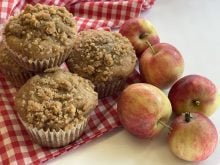Once again we are back at the farm after spending a couple of months in Arizona. Even though we have been home for a month, this is my first article since returning. Betty Ann, Jodie and Barb have been kind and allowed me extra time off before getting back into gear. Thanks.
Grocery shopping is part of daily life, whether in Arizona or at home in Canada. One difference is that in the United States, food products have nutrition facts (calories, fat, cholesterol, sodium, carbohydrate, fibre, sugars, protein, vitamins, minerals) listed on the label.
Read Also

Understand limitation periods if considering civil suit
A limitation period refers to the amount of time a plaintiff has to commence a formal claim in court or lose their ability to pursue it.
The exceptions to these labels are fresh fruits and vegetables, in-store baking and items sold from bulk bins.
An added bonus is that these nutrition facts are often listed in serving sizes, for example one slice or one cookie, rather than by weight or volume, which is much easier to figure out. I miss this information and hope that in the near future Canada will have it too.
Every week the park we lived in printed a newsletter containing information about past and upcoming events, as well as other tidbits for our enjoyment. I’ll share this one with you.
Age is a funny thing
Do you realize that the only time in our lives when we like to get old is when we’re kids? If you’re less than 10 years old, you’re so excited about aging that you think in fractions.
“How old are you? “I’m four and a half.” You’re never 36 and a half, but you’re four and a half going on five.
That’s the key. You get into your teens, now they can’t hold you back. You jump to the next number.
“How old are you?” “I’m gonna be 16.”
And then, the greatest day of your life happens: you become 21.
But then you turn 30. Ooohhh, what happened here? Makes you sound like bad milk. He turned. We had to throw him out. There’s no fun now. What’s wrong? What changed?
You became 21, you turn 30, then you’re pushing 40 … stay over there, it’s all slipping away … then you reach 50 and then you make it to 60. And by then you’ve built up so much speed, you hit 70.
After that, it’s a day by day thing. You HIT Wednesday, you get into your 80s, you HIT lunch. I mean my grandmother won’t even buy green bananas. “Well it’s an investment, you know, and maybe a bad one.”
And it doesn’t end there … into the 90s, you start going backwards: “I was just 92.”
Then a strange thing happens, if you make it over 100, you become a little kid again: “I’m 100 and a half.”
Source: Viewpoint RV and Golf Resort newsletter
Potted plants outside
If you are like me, you have a few plants that bloomed beautifully over the Christmas season and on through the winter, but now are dying back. What to do with them?
It seems a shame to throw them out, although that is one option. This year I’m going to try putting my amaryllis and poinsettia in the garden.
Amaryllis: The Huntington Society sold amaryllis bulbs in our community as a fundraiser for Huntington Disease research and support. It gives these tips. After the flower has bloomed, cut the stalk off to about five centimetres above the bulb. Do not remove the leaves from the plant. When the last chance of frost is past, plant in a partially shaded area in the garden. Before frost returns, and 18 weeks before you want it to bloom, take it out of the garden. Cut off the leaves, wash the roots and store in a dark, cool place for 10 weeks. Make sure it is not stored near fruits and vegetables. After 10 weeks, plant the bulb and it should flower in seven weeks.
Poinsettias: By this time of year, poinsettia leaves will usually have turned yellow, and the bracts shriveled and fallen off. In May, cut the plant back to 15 cm above soil level and repot in a well-drained medium. After the danger of frost is over, poinsettias can be planted outside in a partially shaded location for the summer and watered regularly. When planting, leave the poinsettias potted and place the pot deep enough so the soil comes up to its rim. Bring inside the last week in August or, at the very latest , before the first frost.
To prepare a poinsettia for Christmas, it should be given the short-day treatment for at least 40 consecutive days, beginning about the first week of October. Bracts will color properly when the plant receives natural or artificial light from 8 a.m. to 5 p.m. and uninterrupted darkness from 5 p.m. to 8 a.m.
This darkness can be obtained by placing the plant in a closet, a dark unused room or under a box. After the short-day treatment is over the plant can then have long days of light without affecting the bract color. Horticulturists tell us that failure to bloom is nearly always caused by an interruption of the short-day treatment or excessively warm growing conditions.
Easter lily: To enjoy in your garden, cut off stems and leaves when they are no longer green. In mid-spring, plant the bulbs outdoors, 20 to 30 cm deep, in a sunny area with well-drained soil. The years it takes to reflower will depend on the size of the bulb and local climatic conditions.
Lilies prefer moderately moist soil that feels dry before rewatering. In cold winter climates it is best to bring the bulbs in for the winter and store in a dark cool place. They may survive in the ground over winter if protected by a covering of mulch, such as straw and leaves.
I’ll Never Marry A Farmer
My sister gave me this delightful book, by Lois Hole, for Christmas. Many of you will have benefited from Hole’s gardening expertise and personal stories as told through her books, gardening columns in magazines and on television.
I’ll Never Marry A Farmer, on Life, Learning and Vegetable Gardening contains practical information on 28 of the most popular garden vegetables, including planting dates, typical yields, her favorite varieties, as well as quick tips and tricks. What I like best is her warm, humorous and moving tales of life on her family’s farm near St. Albert, Alta. It’s a great book to pick up from time to time, to read a page or two, or to admire the more than 200 beautiful photographs.
Her friendly and touching stories are certain to put a smile on your face. The book is published by Hole and available at bookstores for $40 or call 780-419-6800.
Peanut butter slice
This easy-to-make, no-bake cake, makes an ideal summertime treat. Not easily crushed, it’s great for picnic baskets and lunch boxes. A favorite with those who have a sweet tooth, including me.
1Ú2 cup brown sugar 125 mL
1Ú2 cup corn syrup 125 mL
1 cup peanut butter 250 mL
1 teaspoon vanilla 5 mL
11Ú2 cups cornflakes 375 mL
11Ú2 cups Rice Krispies 375 mL
Heat and stir brown sugar, corn syrup and peanut butter together until the sugar is dissolved and the mixture begins to bubble or boil. Add vanilla.
Pour syrup mixture over the cereal. Mix well and pack into 8 x 9 inch (20 x 22 cm) square ungreased pan.
Ice with the following icing:
1 cup brown sugar 250 mL
3 tablespoons 45 mL
canned milk
3 tablespoons 45 mL
butter or margarine
1Ú2 -1 cup icing 125-250 mL
sugar
Bring the brown sugar, canned milk and butter to a boil. Boil 11Ú2 minutes. Add icing sugar until thick enough to spread. Slice while still warm.
Health check symbol
Watch for this Health Check TM symbol on food products. It is on a few now and will be added to other food items in the next few months. It tells us that the Heart and Stroke Foundation has reviewed the product and it is a healthy choice. Yoplait’s Yop, a low-fat drinkable yogurt and Caresse, a low-fat fresh cheese, are two products with the symbol.
The Health Check TM symbol has been developed by the Heart and Stroke Foundation of Canada to aid Canadians in their desire to make wise food choices and to help them establish healthy eating habits.
The program considers a wide variety of nutrients including fat (content and type), sodium, dietary fibre, vitamins, minerals and carbohydrates. It has been created in the context of Canada’s Food Guide To Healthy Eating and Nutrition Recommendations.
To find out more about the program, check out the website at www.healthcheck.org. It has information on healthy eating, how companies can join the program and how the program can help consumers when shopping for groceries.
Hospital list
If facing a stay in hospital Barb suggests packing:
- Toothbrush
- Toothpaste
- Mouthwash
- Denture cup
- Deodorant
- Shampoo
- Hand lotion
- Comb
- Cordless razor
- Hairbrush
- Freshly laundered nightgown or pyjamas
- Front opening housecoat
- Flat grip-soled slippers or running shoes
I also found baby wipes or handi-wipes to be refreshing for wiping my face and hands.
Fall decorations
Dear TEAM: While we were away this past winter we collected some large pine cones. I would like to make them into turkeys for Thanksgiving decorations for our fall church supper. Could you tell me how to do this? Also do you have any other suggestions for other fall decorations? – G.H., Rosetown, Sask.
Dear Readers: Do you have any fall or Thanksgiving decoration ideas? Please share them with us, especially the pine cone turkey instructions. We will include your ideas in a future column.
















